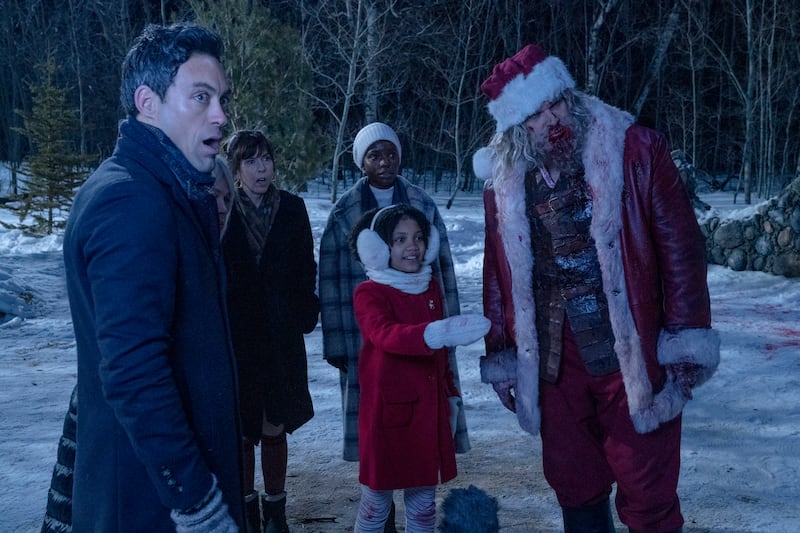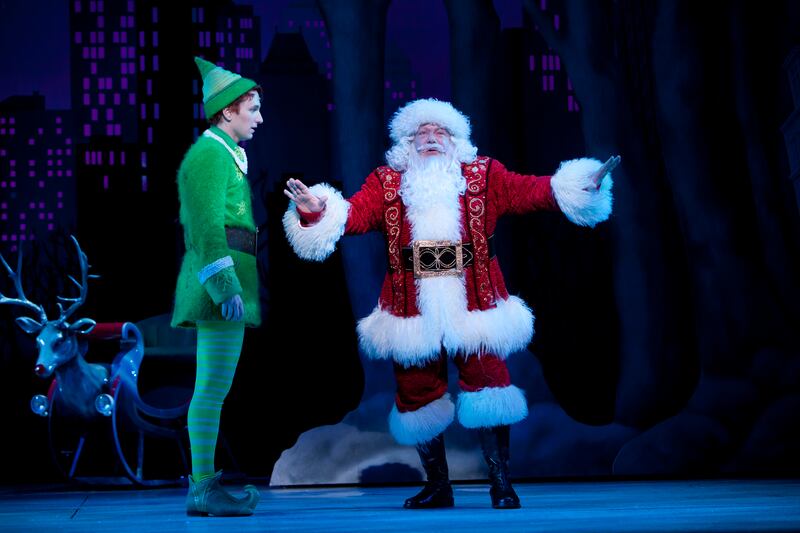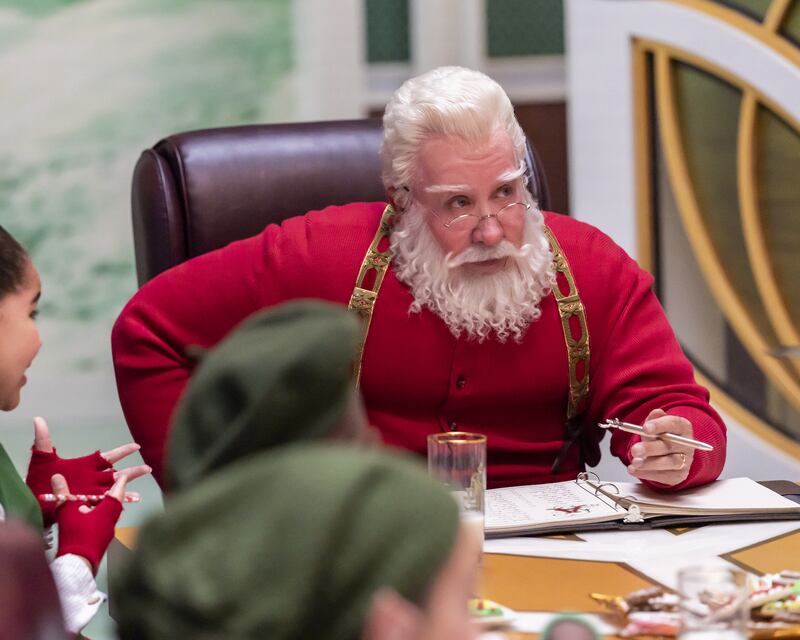David Harbour isn’t the first actor most of us would cast as Santa Claus. Maybe it’s because he prefers to roll in the muck with his characters – the police chief Jim Hopper in Stranger Things, the super-soldier Alexei Shostakov in Black Widow – rather than snuggle with them.
But for the director Tommy Wirkola, Harbour was perfect. For Violent Night, his new holiday gore-fest, Wirkola needed an actor with presence and chops: the ability to play Santa as a drunk depressive who has lost faith in humanity, Christmas and himself, but whose goodness still radiates.
“Literally in our first meeting, somebody brought up his name, and it was one of those moments where we just looked at each other,” Wirkola says in a video call from Los Angeles. “It was almost too obvious; it’s such a good idea.”
Violent Night puts Santa in the right place at the wrong time, a Christmas Eve heist at a billionaire’s mansion. He’d happily fly back up the chimney were it not for seven-year-old Trudy (Leah Brady), who has pleaded for help over the walkie-talkie her parents told her was a direct line to Santa. So he digs deep into himself and his sack of toys to summon the courage and the weaponry to save her.
Summer 2025: 100 great restaurants, cafes and places to eat around Ireland
Housewife of the Year review: A reminder that Ireland of the 1970s and 80s was no country for women of any age
‘There’s a menace, an edge to life in America that wasn’t there before. And the possibility of dark stuff’
Netflix, Prime Video, Disney+, Apple TV+: 10 of the best new shows to stream in June
“I’m pretty sure it’s intimidating to some extent for an actor to do the role of Santa Claus,” Wirkola says. “So many actors have done it before, in so many movies. So how can we make it stand out?”
[ Who is the best cinema Santa Claus of them all?Opens in new window ]
Suiting up as St Nick may sound like a frolic around the tannenbaum, a welcome break from more serious roles.
If only.
We talk to three stars about what goes into portraying a Santa for the ages.
David Harbour, Violent Night

As Harbour and Wirkola fleshed out their Santa, they decided he couldn’t be comical or the movie wouldn’t work. So Harbour played him straight.
“It’s just inherently funny when people treat him as if he’s in on the joke, like, ‘Oh hello, Santa’,” he says, “and he’s completely deadpan because he is Santa.”
And because the dynamic between Trudy and Santa needed to be respectful – and never condescending or cloying – Harbour watched the 1947 version of Miracle on 34th Street on his iPhone at night, recording scenes with the Santa and the child characters to discuss the next day as he and Wirkola developed the script.
“That was the real movie I thought about all the time on set,” he says by video from Budapest, Hungary, where he was shooting the upcoming film Gran Turismo.
Harbour’s Santa was visually modelled on an old-school Coca-Cola advertising fantasy, with a curlicue beard and rosy cheeks. But that Santa wouldn’t drink himself horizontal or power-vomit on a woman. Nor would he display a Viking’s ferocity.
This Santa was a warrior, which meant that Harbour had to become one, too. But as more of Santa’s origin story was revealed through action sequences, the question became what to show when.
“David was adamant that he didn’t want him to be too good too quickly, or too cool too quickly and say too many cool lines too fast,” Wirkola says. “In the first couple of fights, he’s stumbling around and barely surviving. David didn’t want him to feel superhuman in any way.” Even if Harbour sometimes felt that the role’s demands required feats of imagination that more dramatic roles – where the depth and complexity is written into the script – did not.
“It was a lot of digging in and trying to create a character and an arc that would be meaningful,” Harbour says. “The funny thing is, we might look down on work that happens in a soap opera or an action movie as being not artistic. But when I see somebody do something impressive in a soap opera, I’m always like, ‘You must have worked really hard on that’.
“And yeah, I worked really hard.”
George Wendt, Elf: The Musical

George Wendt used to joke that if you stayed fat enough and got old enough, the Santa roles would start rolling in. But that was hardly what landed him Elf: The Musical, a 2010 stage adaptation of the 2003 Will Ferrell comedy. (He reprised the role in 2017 at Madison Square Garden, in New York.)
“Did I want to be in the original cast of a new Broadway musical? It was a big yes,” Wendt, who is now starring in the romcom Christmas With the Campbells on Amazon Prime Video, says in a call from Los Angeles. “I had just been on Broadway in Hairspray. I was fresh meat, so to speak.”
His instinct, and that of the show’s writers, was to humanise his Santa, maybe make him a little funnier than you’d think he would be – but go light on the schmaltz.
“Any time I started to veer into what might be sappy Santa, Casey Nicholaw, the director, would be like, ‘Bup bup bup bup bup, don’t you dare!’” Wendt says. “He wanted me to keep it real and flip, not a reverential Santa in any way.”
Wendt has played Santa five or six times – he’s lost count – and while Elf might have been his highest-profile gig, A Colbert Christmas: The Greatest Gift of All!, in 2008, was his weirdest one.
“I came down the chimney with a bowie knife between my teeth because this bear was stalking Colbert,” he says, referring to the late-night host Stephen Colbert. “So I brawled with the bear, and I ripped him open with my knife, with Colbert cowering in a corner. And when I slit his belly open, Elvis Costello came out dressed as Bob Cratchit.”
But whether he’s cracking New Jersey jokes, like in Elf: The Musical, or saving TV hosts, being Santa comes with an inescapable irritant that makes you wonder how the jolly old fellow grew rotund in the first place.
“It’s really hard to eat much with all that hair on,” Wendt says. “That beard – that’s awful. It just goes right in your mouth, no matter how careful you are.”
Tim Allen, The Santa Clause

For nearly three decades, Tim Allen – who jokingly claims not to be fond of children, his own included – has played Scott Calvin, a divorced dad forced to fill Santa’s suit and boots, starting in The Santa Clause (1994). Two sequels later, he has extended his run with The Santa Clauses, a new Disney+ series about Calvin’s quest to find a worthy successor.
Now Allen can’t get away from kids.
“I have to make up stories to real children all the time when their parents say, ‘This is Santa Claus,’ and I’m like, ‘No, it’s not’,” he explains in a call from Manhattan. “I play along, and I joyously do it. But it’s a little overwhelming, to be honest, for a very aggressive comedian.”
In fact, The Santa Clause was a far darker comedy when Allen signed on. He kind of remembers that Calvin might have shot Santa.
“To this day, it’s one of the best scripts, top to bottom, I’ve ever read,” he says.
But for the series, Allen wanted – demanded, really – a story with a beginning, middle and end, as well as explanations for some lingering questions about what happened to the original Santa and the process for selecting a new one.
“We answered those in a very wonderful, organic way,” he says. “So I had, in this one, conceptual strength in the script room. ‘Let’s get to these points and the jokes will come. And once we get to the funny stuff, I can add.’ That’s kind of my strength.” Physically getting into character originally was not.
In the first film, Allen spent four hours in the chair each day, often followed by 10 hours in a hot, heavy suit – an affair he called psychotic.
The process has since been streamlined, but its effect is still undeniable.
Allen recalls the hush that fell over 225 people on the first day of shooting not so long ago, as he walked on to the set in his gorgeous velvet suit and uncannily realistic headpiece with beard, moustache and flawless skin that makes him look younger even if you’re right next to him.
“And all of a sudden you have adults, half adults, children looking at me with these big grins on their faces, and they’re silent,” he says. “I realised the magic of this image – that whatever it means, it means the same thing to all of the children in these people.
“It’s a responsibility. I don’t make fun of it.” – This article originally appeared in The New York Times
[ 25 Christmas movies for the 25th (and other days)Opens in new window ]













